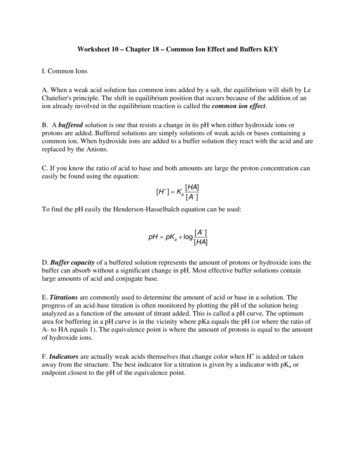
Transcription
Worksheet 10 – Chapter 18 – Common Ion Effect and Buffers KEYI. Common IonsA. When a weak acid solution has common ions added by a salt, the equilibrium will shift by LeChatelier's principle. The shift in equilibrium position that occurs because of the addition of anion already involved in the equilibrium reaction is called the common ion effect.B. A buffered solution is one that resists a change in its pH when either hydroxide ions orprotons are added. Buffered solutions are simply solutions of weak acids or bases containing acommon ion. When hydroxide ions are added to a buffer solution they react with the acid and arereplaced by the Anions.C. If you know the ratio of acid to base and both amounts are large the proton concentration caneasily be found using the equation:[H ] K a[HA][ A ]To find the pH easily the Henderson-Hasselbalch equation can be used:pH pK a log[ A ][HA]D. Buffer capacity of a buffered solution represents the amount of protons or hydroxide ions thebuffer can absorb without a significant change in pH. Most effective buffer solutions containlarge amounts of acid and conjugate base.E. Titrations are commonly used to determine the amount of acid or base in a solution. Theprogress of an acid-base titration is often monitored by plotting the pH of the solution beinganalyzed as a function of the amount of titrant added. This is called a pH curve. The optimumarea for buffering in a pH curve is in the vicinity where pKa equals the pH (or where the ratio ofA- to HA equals 1). The equivalence point is where the amount of protons is equal to the amountof hydroxide ions.F. Indicators are actually weak acids themselves that change color when H is added or takenaway from the structure. The best indicator for a titration is given by a indicator with pKa orendpoint closest to the pH of the equivalence point.
The following is an acid-base equlibrium problem that involves many of the topics we havediscussed in chapters 17 and 18. For each of the following solutions:a. Describe (in words) what happens.b. Write a chemical equation that describes what happens.c. What is the proton donor? Why?d. What is the proton acceptor? Whye. After this solution has reached equlibrium: What species are present? What is theirconcentration? What is the pH and pOH?1. Benzoic Acid (C6H5COOH) is a solid. 15.000 grams is dissolved in distilled water anddiluted to 200.00 mL.
2. Sodium benzoate (NaC6H5COO) is a solid. Used as a preservative in most sodas. 10.000grams is dissolved in distilled water and diluted to 100.00 mL.
3. Sodium Hydroxide is a solid. 5.0000 grams is dissolved in 50.0 mL of distilled water.
4. The benzoic acid solution and the sodium benzoate solution are mixed together in a largeflask.
5. 1.00 mL of the sodium hydroxide solution is added to the buffer.
6. 10.00 mL of the sodium hydroxide solution is added to the buffer.
7. 25.00 mL of the sodium hydroxide solution is added to the buffer.
ion already involved in the equilibrium reaction is called the common ion effect. B. A buffered solution is one that resists a change in its pH when either hydroxide ions or protons are added. Buffered solutions are simply solutions of weak acids or bases containing a common ion.










